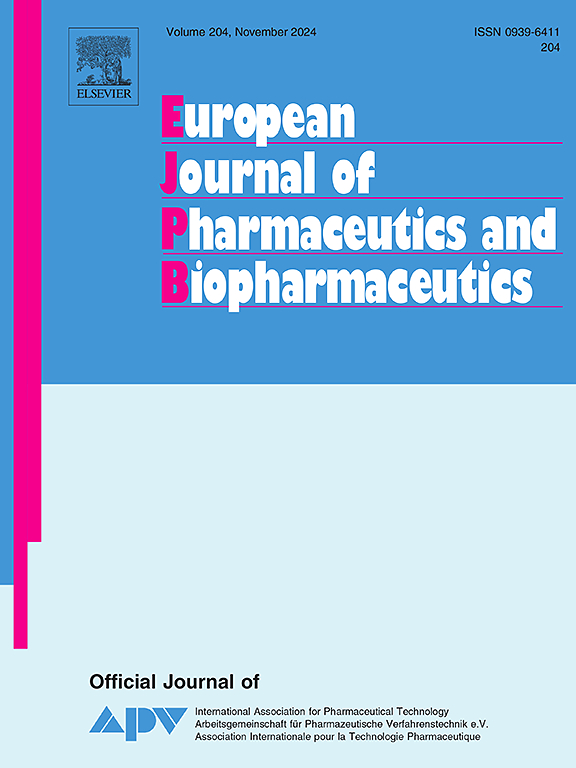Enhancing the therapeutic efficacy of piperine in colorectal cancer: development and evaluation of piperine-loaded PLGA-b-PEG copolymer nanoparticles
IF 4.3
2区 医学
Q1 PHARMACOLOGY & PHARMACY
European Journal of Pharmaceutics and Biopharmaceutics
Pub Date : 2025-06-18
DOI:10.1016/j.ejpb.2025.114796
引用次数: 0
Abstract
Colorectal cancer (CRC) is the third most common cancer and the second leading cause of cancer-related morbidity and mortality worldwide. Piperine, a natural alkaloid from Piper nigrum L. and Piper longum L., has shown potential anti-cancer properties, including the ability to induce apoptosis and inhibit cell cycle progression. However, its clinical application is limited by low solubility and poor bioavailability. In this study, we developed piperine-encapsulated PLGA-b-PEG nanoparticles (Pip-PLNP) using a nanoprecipitation method, which achieved a favorable hydrodynamic diameter of approximately 43.8 ± 0.4 nm to 49.1 ± 0.2 nm and high encapsulation efficiency (∼80 %) in a stable, monodisperse form. The anti-cancer effects of Pip-PLNP were evaluated in HCT116 human colorectal carcinoma cells. MTT assays revealed that Pip-PLNP exhibited significant dose- and time-dependent cytotoxicity, with improved potency compared to free piperine. Apoptosis assays demonstrated that Pip-PLNP induced early and late apoptosis more effectively than free piperine. Additionally, cell cycle analysis showed that Pip-PLNP caused G0/G1 phase arrest, consistent with piperine’s known mechanism of action. In conclusion, Pip-PLNP significantly enhances the anti-cancer efficacy of piperine by improving its bioavailability, cytotoxicity, and apoptotic activity, suggesting its potential as a therapeutic approach for colorectal cancer treatment.

提高胡椒碱在结直肠癌中的治疗效果:胡椒碱负载PLGA-b-PEG共聚物纳米颗粒的开发和评价
结直肠癌(CRC)是全球第三大常见癌症,也是导致癌症相关发病率和死亡率的第二大原因。胡椒碱是一种天然生物碱,来自于黑椒和长椒,具有潜在的抗癌特性,包括诱导细胞凋亡和抑制细胞周期进程的能力。但其溶解度低、生物利用度差,限制了其临床应用。在这项研究中,我们使用纳米沉淀法开发了管道封装的PLGA-b-PEG纳米颗粒(Pip-PLNP),该纳米颗粒在稳定的单分散形式下获得了约43.8±0.4 nm至49.1±0.2 nm的良好流体动力学直径和高封装效率(约80%)。在HCT116人结直肠癌细胞中评价了Pip-PLNP的抗癌作用。MTT试验显示,Pip-PLNP表现出明显的剂量和时间依赖性细胞毒性,与游离胡椒碱相比,其效力有所提高。细胞凋亡实验表明,Pip-PLNP比游离胡椒碱更有效地诱导早期和晚期细胞凋亡。此外,细胞周期分析显示,Pip-PLNP导致G0/G1期阻滞,与胡椒碱已知的作用机制一致。综上所述,Pip-PLNP通过改善胡椒碱的生物利用度、细胞毒性和细胞凋亡活性,显著增强了胡椒碱的抗癌功效,提示其有可能成为治疗结直肠癌的一种治疗方法。
本文章由计算机程序翻译,如有差异,请以英文原文为准。
求助全文
约1分钟内获得全文
求助全文
来源期刊
CiteScore
8.80
自引率
4.10%
发文量
211
审稿时长
36 days
期刊介绍:
The European Journal of Pharmaceutics and Biopharmaceutics provides a medium for the publication of novel, innovative and hypothesis-driven research from the areas of Pharmaceutics and Biopharmaceutics.
Topics covered include for example:
Design and development of drug delivery systems for pharmaceuticals and biopharmaceuticals (small molecules, proteins, nucleic acids)
Aspects of manufacturing process design
Biomedical aspects of drug product design
Strategies and formulations for controlled drug transport across biological barriers
Physicochemical aspects of drug product development
Novel excipients for drug product design
Drug delivery and controlled release systems for systemic and local applications
Nanomaterials for therapeutic and diagnostic purposes
Advanced therapy medicinal products
Medical devices supporting a distinct pharmacological effect.

 求助内容:
求助内容: 应助结果提醒方式:
应助结果提醒方式:


